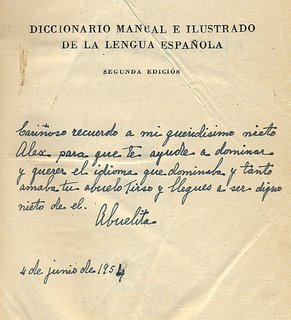


When you stop reading your native language you lose it. It wasn't until about 11 years ago that I re-discovered it through Manhattan Bookstore and its present incarnation as Sophia Books. Sophia Books has been taking my orders for books in Spanish since. I found treasures at the UBC Library. It has all the literary output of Cuban writer Alejo Carpentier who coined the "real maravilloso" or magic realism. I have read and re-read "Viaje a la Semilla" or Journey Back to the Source, a short story in which all action happens backwards. It begins with a wake in which the burning candles get longer and longer and ends with the nails on a ship tearing themselves out and zooming to their source, the mines.
At least half of what I read is in Spanish. While I cannot read Portuguese I delight in reading all of José Saramago, translated into Spanish by his wife Pilar. And Perez-Reverte's swashbuckling Capitan Alatriste novels are the closest I will ever get to living in Paris in the 19th century while waiting for Alexandre Dumas's next installment of the Three Musketeers.
I cannot imagine reading Spanish in Vancouver without being able to share my delights with others who speak and read the language. Alas, Juan Manuel Sanchez and Nora Patrich have gone to Buenos Aires until December and my music conductor friend Juan Castelao is in Oviedo, Spain working on his masters until next June. I miss them. I bought a slew of books in Spanish at Sanborn's in Morelia. A couple of them are by Spanish authors. Juan Castelao would know about the authors. Castelao reminds me of my Abuelita (grandmother). My grandmother was proud that her husband and my grandfather, Don Tirso de Irureta Goyena was one of the few Filipinos who had been inducted into the venerable Real Academia Española. In 1954 she gave me a Real Academia Dictionary and reminded me in the dedication how I should love the Spanish language as much as her Tirso had. When I showed Juan my money belt that I had purchased for a trip, he said, "Una faltriquera." Juan knew the exact word for it in Spanish. And of course the dashing Capitán Alatriste wears one right nexct to this trusty foil.
There are no more lazy afternoons at Juan and Nora's discussing in Spanish world events and art while sipping mate. Juan keeps assorted varieties of crackers and cookies in a tin and serves these with the mate. Nora is the one who prepares (cebar) the mate. To cebar a mate is close to making tortillas by hand. Inexplicably some people can and some can't.
I miss meeting with Juan Castelao at Nando's for extra hot chicken wings (he likes the chicken livers) or discussing the merits (unknown to me until now) of Bruckner.
I miss them and I consider myself so lucky that I do.
Real Academia Española